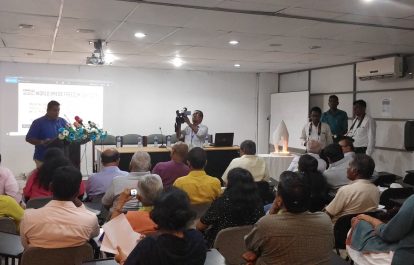SAMSN Blog
#WPFD2018: Media Reforms – the Present and Beyond
03 May, 2018
Delivering the keynote address at the World Press Freedom Day event on May 2, 2018, organized by the Free Media Movement at the Sri Lanka Press Institute, MJR David provides a succinct analysis of media reforms in Sri Lanka.
There have been many efforts to develop proposals for media reform, and several reports have been produced. Yet, there have not been many concrete outcomes.
It may not be unreasonable to conclude that this frustrating scenario has contributed to a loss of direction within the media landscape. Broken promises and lost opportunities are the hallmark of the media reform agenda of Sri Lanka.
Media reform has always ranked high on the political agenda at election time. An analysis of the recent past revels that free media and reform has been a key pledge across the board for all political parties. The initiatives taken towards media reform range from protest, civil society initiatives, election manifestos, internal review of state media, government commissions and public interest litigation.
Key Initiative towards media reform (1963-2018)
| Year | Initiative | Key output |
| 1963 | Press Commission Report | Proposals to control the Press and subsequently the establishment of the Press council. |
| 1966 | Establishment of the Sri Lanka Broadcasting Cooperation by a Parliamentary Act | Establishment of a State Monopoly on electronic media (1982 Sri Lanka Television Cooperation Act) |
| 1989 | All party conference on youth unrest | Recommendations for youth participation in media |
| 1991 | Lakshman Jayathilaka Commission on youth unrest | Recommendations on youth engagement thru media |
| 1994 | Election Manifesto of the Peoples’ Alliance | A pledge for sweeping media reform including repealing counterproductive legislation and development of new structures |
| 1994 | Sidath Sri Nandalochana Report on Lake house | Broadcasting the organization and democratization of the institution |
| 1996 | RKW Goonasekara Report on Legal Reform | 52 recommendations on media reform were presented and this remains a comprehensive legislation on the legal aspect of media reform |
| 1998 | Colombo Declaration
A Document of understanding signed by the Free Media Movement, Editors’ Guild, newspaper publishers’ association and later Working Journalists Association |
A broad agreement and vision on how to manage,condct and regulate media |
| 2005 | Presidential Task force on Mass Media -2005 | A range of recommendations on Media content issues |
| 2005 | Tholangamuwa Declaration | Proposals fora public service media from a collective of media organizations |
| 2006 | Gender and Media Charter | A broad understanding among journalist on how to report gender issues |
| 2006 | Waligma Declaration | A Broad set of principles on how to report ethnic issues and reconciliation |
| 2007 | National Media Policy prepared by the ministry of media and information | A guideline for journalist on how to report and recommendations on policy matters |
| 2008 | Colombo Declaration on Media Freedom and Social Responsibility | Revisit to Colombo Declaration (1998) |
| 2010 | Kelaniya Declaration – Department of Mass Communication | Recommendation from University academics to the government on media reform an media training and development |
| 2016 | A Report on Restructuring media compiled by the National Secretariat for Media Reform | A study evaluating the Sri Lankan media context against UNESCO indicators |
| 2016 | Blue Print For Media Reform – Free Media Movement | Free Media Movement prepared this report with the view of looking at the need for media reform |
| 2017 | Media sustainability index – Development Journalist Forum | An evidence-based review on the Sri Lankan media context |
Many of the proposed reforms are recommendations that are yet to become a reality and there cannot be much debate on that proposition that the project of media reform has failed badly.
In 2015 a key pledge to the media was that journalists would not be harmed, but this pledge was broken. Since the election of the new government the number of attacks on journalist have decreased although not satisfactorily eliminated. A number of those who are responsible for silencing the media by killing and abducting journalist and media workers are yet be held accountable for their acts.
On the front of legislation enacting the Right to Information Act certainly deserves praise and moves to regulate the electronic media in a consultative manner are underway. Other than that, legislative reform has not made progress. Likewise, media education and training is very much below acceptable standards.
In a context where society has not been able to get its basics correct is there any use of lamenting that reforms of a higher order have not been carried out?
On the other hand, there is a popular belief that our political managers of post-independence Sri Lanka have failed miserably in delivery of pledges. One could question whether it is logical to repeatedly blame those who have frequently failed? Would it not be better to explore alternatives?
But before we explore alternatives lets reflect on the failures or less than successful experiences of media reform. Here are some of the reasons I have heard from the community of media professionals and journalists on the failure of the media reform agenda:
- Media reform is not a continuous, but only a sporadic intervention that is driven by external forces or artificially generated interest such as election pledges.
- There is no problem analysis carried out by respective stakeholders, nor is there systematic advocacy. It is more a random intervention by parties with specific interests.
- Media reform is more a reaction to identified issues rather than a proactive process.
- Current media reform proposals are outdated. The changes in the media landscape such as emergence of social media and convergence need to be taken into account.
- There is no enabling environment to support progressive legislation
- Media is not a business in the real sense and such media operations are not sensitive towards reform.
- Electronic media operators have obtained licenses with very vague conditions that are beneficial to them and they may feel restricted by reform and thus may reject a reformist agenda.
- Regulating electronic media by legislation is an outdated exercise, the focus should be on next generation media and content rather than conventional media delivery forms. This calls for a paradigm shift directed towards the consumer and not the producer. This needs to be done through a media literacy advocacy intervention.
- A Media reform mapping exercise needs to be carried out to identify priority areas in order to develop a road map for change.
- Stakeholders need to be given due recognition and mutual respect, the government needs to be convinced and civil society needs to be respected. The interaction between stakeholders need to be worked out and this has not happened sufficiently.
- The integrity of certain media reform activists is in question
- There is a lack of media literacy among the wider population and this poses a constraint in developing an enabling agenda.
- Lack of professionalism among the journalist community has led to an anti-reform or attitude of indifference towards media reform.
Given all of the above, do we then abandon media reform and allow market forces, social forces and the industry to operate on an auto-pilot mode? Or are we to push harder for the reformist agenda to succeed? Or are we to allow technological innovation to dictate the media agenda?
These are certainly questions that require answers, but in this instance, a change of approach is suggested. At risk of over-simplification, the new approach could be a change from a linear approach to one of complexity that takes into account diverse situations, scenarios and no fixed answer or end goal. The complexity approach recognizes that outcomes are less than predictable and that diverse outcomes emerge as the process evolves. There are expected outcomes as well as unexpected outcomes.
The media is not one single entity but a collective of multiple universes. It is not many voices in one world, but many voices and many worlds. There is not one question but many questions and many answers, while some questions have no answers. It is a scenario of multiple realties that sometimes act in concert and some act independently or indifferent of each other. In this context a serious rethinking of the media reform agenda is proposed.
At least five elements of a media reform ecology could be identified to be integrated within a complexity approach:
- The legislative and constructional framework
- Media literacy framework in the context of the public sphere
- The technological complex framework
- Action and reaction of the media industry
- The complex whole created by the interaction of the above elements and any other factors.
A complexity approach should be able to manage tensions that emerge within the interaction of these elements in a manner that would fulfill at least some of the needs and aspirations of the stakeholders.
It must be noted that a shared vision of change among stakeholders will help to achieve certain goals, while a space for the inevitable difference of opinion and disagreement among stakeholders must also be created. These differences need to be treated as a disruptive space that would contribute towards an enabling environment.
The complexity approach for change in the media landscape will need the management of tensions among stakeholders in a manner that would not be counterproductive. Compared to a linear media reform approach, the complexity approach is challenging and dynamic.
Is the Sri Lankan society ready for such an approach and willing to take up this dynamic challenge?
MJR David is senior lecturer at the Department of Mass Communication, University of Sri Jayawardhanapura, Sri Lanka.
Written By
 Free Media Movement
Free Media Movement
Free Media Movement c/o SLPI, No 96, Kirula Road Colombo 05, Sri Lanka Telephone: +94 777 394 959 Fax: +94 11 257 3279
Comments
Resources
- IFJ South Asia Media Bulletin, February 2023 02/15/2023 Download
- IFJ South Asia Media Bulletin, January 2023 01/18/2023 Download
- Nepal Press Freedom report 2022 01/03/2023 Download

